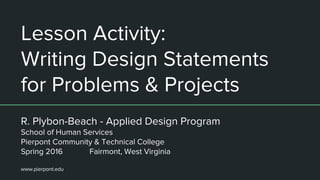The writing design statement appd 2200 spring
- 1. Lesson Activity: Writing Design Statements for Problems & Projects R. Plybon-Beach - Applied Design Program School of Human Services Pierpont Community & Technical College Spring 2016 Fairmont, West Virginia www.pierpont.edu
- 2. Creating Your Design Statement (Creative Brief) ŌŚÅ Intro ŌŚÅ The Design ŌŚÅ Location, History of Project ŌŚÅ Likes & Dislikes of client ŌŚÅ Occupants, Users and Visitors ŌŚÅ Needs and/or Goals ŌŚÅ Budget ŌŚÅ Timeline
- 3. Objective Designing is a cultural way of acting on a need to create. At the beginning we think about the situation and begin to mentally see a systemic network developing of the components necessary to achieve what we desire. The following are steps to take in identifying the components in an orderly manner to continue our active design thinking in anticipation of meeting the goal. The design may be a project (visible and applicable for a user) or an act of coordination such as developing an organization for a group. (Subjective or Objective) There is a Design Way of Thinking with a foundational platform and fundamentals in addition to the practice of applying the Design Process. In the process we begin with a statement or a creative brief. This statement is a tool for everyone involved in the project. It is used as a way of knowing the design problem and goals. The Statement sometimes includes the design solutions also known as the concept.
- 4. INTRO ŌŚÅ Who you are ŌŚÅ What type of design ŌŚÅ Who is the client ŌŚÅ How did they choose you The Design Tradition Design Service Human Rule Ambiguity Rule
- 5. What and Who are in the ŌĆ£IntroductionŌĆØ
- 6. My company Who are you? My Client Who are they? What type of Design I provide this Design Service How How the client choose you for the solution Proceed to next part of the statement (brief or concept)
- 7. The Design ŌŚÅ The ClientŌĆÖs Situation ŌŚÅ The Problem ŌŚÅ What is particular (unique) The Problem The Particular
- 8. What is the problem?
- 9. The Problem (Wicked or Tame) A designer is needed to resolve this situation Parts of the problem What are the particulars of the problem The Ultimate Particular The dominant part in this design Design Need The main goal of the design Proceed to next part of the statement (brief)
- 10. Example IMAGE CREDIT: HuffDesign Blogger http://bhuff12.blogspot.com/2013_10_01_archive.html
- 11. The Location History of the Project ŌŚÅ The geographical information ŌŚÅ The short story of the project ŌŚÅ Leading to the current problem The Systemics The Whole
- 12. Where is this project? What is the story?
- 13. The Location Where is this project? The History What is the background on this project The Relationship The pertinent historical facts on the project and how it relates Design Need The main goal of the design Proceed to next part of the statement (brief)
- 14. The Likes and The Dislikes ŌŚÅ What are your clients tastes ŌŚÅ The positive ŌŚÅ The negative The Relationships The Whole
- 15. What are the likes and dislikes of the client(s)?
- 16. The Likes What do the client(s) like or tastes? The Dislikes What the client(s) do not like. The Overall What the project relates to in the answers of the likes and dislikes Design Need The main goal of the design Proceed to next part of the statement (brief)
- 17. The Occupants The Needs & Goals ŌŚÅ The project effects who? ŌŚÅ The needs ONLY ŌŚÅ The ultimate GOAL(s) The Design Problem Defined
- 18. Who does this project affect in the end? What are the defined needs and goals?
- 19. The Who Who will be affected with the final outcome of the project The NEEDS Only the needs The Goal(s) The goal(s) for the project Design Need The main goal of the design Proceed to next part of the statement (brief)
- 20. The Budget The Timeline ŌŚÅ The investment for the project ŌŚÅ The contingency ŌŚÅ The timeline The Particulars
- 21. What can you afford or invest? What is the timeline?
- 22. The Cost What kind of investment do you plan on committing The Options Are there alternatives to consider The Timeline When do you need the finished project? Begin & End The main goal of the design THIS FINAL SENTENCE LEADS YOU TO WANTING TO KNOW THE SOLUTIONS TO CONSIDER























